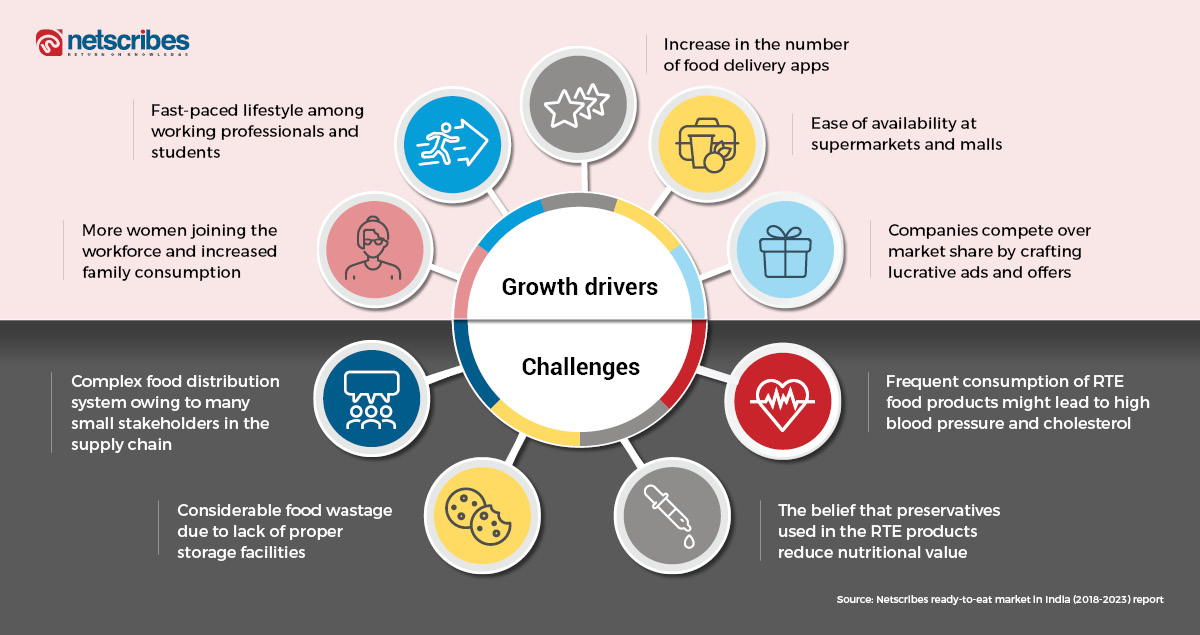The ready-to-eat (RTE) market in India is anticipating significant expansion in the coming years, thanks to the rapid urbanization and growth in per capita income across the nation. The increasing number of working professionals are the major drivers of this market growth. Netscribes suggests the RTE market will reach a total worth of INR 50,900 million (USD 709 million) by 2023. Here’s a deep-dive detailing the growth factors, challenges, and key trends in the industry.
Growth drivers
Surge in per capita income and average consumption
Aside from the rise in per capita income, many women have joined the workforce. This allows an increase in the number of earning members in a family, raising per capita spending capacity.
Rapid urbanization
Cities and urban settlements have more employment opportunities than villages, leading to a growing exodus of people leaving rural settlements for urban ones. The fast-paced urban lifestyle for working professionals and students living away from home has catalyzed the demand for ready-to-eat food. Typically, in recent times, both spouses go out for work, causing a reduction in cooking time. In many cases, ready-to-eat food acts as the active source of sustenance.
The advent of numerous food delivery mobile apps
An on-the-go lifestyle has compelled many Indians to rely on ready-to-eat products that can be ordered via mobile apps like Swiggy, Foodpanda, and Zomato. This has led to a visible growth in the consumption of a wide range of ready-to-eat food products through these channels. It’s no surprise why the online food delivery sector is expected to grow to a value worth INR 162 billion (USD 2.2 billion) by 2021.
Growth in retail marketing of frozen foods
There has been a significant proliferation of retail outlets, especially in the country’s tier I and II cities. Shopping malls and supermarkets have become significant points of sale for RTE and frozen food items, accounting for nearly 75% of frozen food sales. Players in this industry are crafting strategies to inspire cravings for such products. They are doing this through promotional campaigns that inform customers about exclusive stores where their products are available.
Attractive advertising and promotional campaigns help popularize RTE products
Players within this field offer similar products, with minor distinctions in terms of taste, price, and quality, leading the aggressive competition within the market. Hence, companies are always looking for ways to make their promotional campaigns as attractive as possible, especially in tier I, tier II cities and rural markets, battling over consumer mindshare and recall value. Once brand awareness is achieved players are convinced that impulse buys will trigger sales and eventually inspire loyalty.

Challenges
Lack of effective product distribution system
The RTE market in India is largely composed of unbranded products. As a result, the supply chain contains many small stakeholders like raw material producers, research and quality testing units, suppliers of RTE manufacturers among others. Many such siloed units are making the food distribution system a complex one. Also, lack of proper storage facilities end up in considerable food wastage. To avoid this, third party distributors have been plugged into the supply chain, leading to additional operational cost.
Negative perception affecting consumer behavior adversely
It is noticed that most of the aged city dwellers are under the impression that the food-preservatives used in the RTE products reduce their nutritional value. As a result, they prohibit the younger generation from consuming the packaged ready-to-consume food products, hampering overall RTE product sales in India.
Increased health concern
Many health experts state that frequent consumption of RTE food products might lead to high blood pressure and cholesterol. Also, such food items develop hypertension, diabetes and heart diseases. This deters health conscious consumers from purchasing such food products. Indians often consider that packaged ready-to-consume food items contain a high concentration of salt, sugar, and fat. These beliefs deter them from consuming such products.
Key trends
Focus on nutritious packaged foods
Many families still compel their younger members to have home-cooked meals, due to the lack of trust in RTE foods. This is causing many RTE companies in India to focus positioning their products as having high nutritional value. For instance, McCain foods, though relatively new to the Indian market, provides its customers with a range of delicious frozen foods, including French fries, aloo tikki and cheesy bites.
Breakfast for schooling children
Parents of teenagers and children attending afternoon schools are quite particular that their kids have a high nutrition breakfast. In a country where milk is thought of as having wholesome nutritive value, mixing cereals with it is believed to be highly nutritious. It is this belief coupled with the American breakfast enculturation through media that has earned brands like Kellogg’s cornflakes and Quaker oats instant and growing popularity.
For an in-depth competitive analysis and consumer research on the ready-to-eat market in India, contact info@test.netscribes.com.






